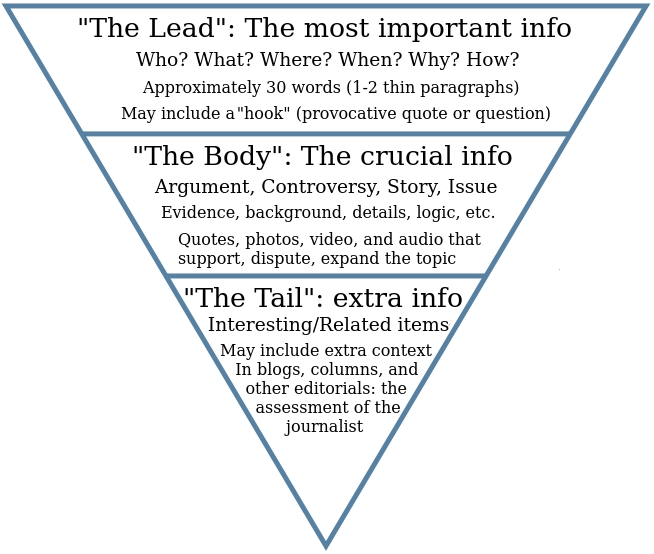
This week we will continue writing a news report, but this time, we will base it on an original report gathered and written by you. We will continue to focus on the reporters’ inverted pyramid, which was introduced to you last week.
Below you will find a scenario about a plane accident that occurred nearby. There are also several eyewitnesses interviews, which you conducted after the accident. Your goal is to write a news story about the accident incorporating the facts and testimony from several eyewitnesses.
Scenario
The aircraft was a Cessna 150, a two-seat light plane piloted by Thurgood Vance, 24, who lives on Rt. 208 in Goshen, NY. The plane crashed into a wooded area just south of the U.S. Rt. 300 in the town of Orangeburg, across the road from Dominican University. Pilot is dead. He was alone in the plane. The plane was burned and the body was inside. The craft departed from the Frost Valley, NY landing strip at 11:15 a.m. Crashed shortly after noon. The crash is still under investigation. The Federal Aviation Administration will send an investigator in tomorrow to look over the wreckage and the crash site. [Source: Police Chief Buford Hunicut]
From AnnMarie DeSiena, an Associate Professor at Dominican University: “I don’t know anything about flying, but I think this guy is a hero. He literally gave his life to keep our students out of danger. It looked to me like he was trying for an emergency landing along Route 300, because his engine was sputtering and the plane was balky. And then he saw we had a couple of student athletes out running the track right next to the roadway. He must have been worried that he couldn’t control the plane and it might careen over into the students. Next thing I knew, why, he just pulled the nose of the plane up and banked left into the woods, across the road from the students. The plane went into the woods and exploded. Bless his heart.”
From 21-year-old Alessandro Guzzinati, a student at Dominican University. “I was running around the track, trying to go slow, and the coach was hollering at me to speed up, and then I heard what I thought was really loud screaming, but not like from a person, you know? More like from a motor or something, and then this big whoosh, and then I looked up and it was like the trees were on fire. I never saw an airplane, just heard these weird noises and then the woods caught fire.”
From Sven Hemmert, a construction worker at New York State Department of Transportation’s maintenance facility, who was across the road from the crash site: “We had come back to the maintenance barn for some post hole diggers, and suddenly all the guys are like ‘Holy shit! He crashed!’ And I’m like, ‘What? Who crashed?’ So we hopped in the truck and went hauling ass over there, but the fire wouldn’t let us close enough to get him. But it was close enough to see him burning inside the plane. So I, just, you know, hurled my breakfast.”
From Theresa Fall, chair of the county Board of Supervisors: “I just feel awful. I’ve known Thirsty since the day he was born, and I’ve known his mother and dad since I was a child. Such dear, dear people. What a terrible loss for them. I’ve been to see them, and they are devastated, of course, but I was able to tell them that their son apparently is a hero. That seemed to help a bit. I’m planning to introduce a resolution with the board to recognize him.”
From Amina Kabia, a Dominican University student who was walking to class at the time: “Oh, God, it was just so totally gross. The plane just, like, blew up in midair. One minute it was flying low over Dominican University, and the next, you know, bam! I was walking at the time, so it went right over my head and right into those trees. I think it just missed the Casey Hall.”
From Thom Nowak, the Academic Dean at Dominican University: “One of the secretaries in the office said, ‘I can hear a plane’s engine cutting off,’ and so we ran outside, and, sure enough, this little plane was having a tough time keeping altitude and staying trim. I started running toward the track, because I saw the students out there. I don’t know what I could have done if he’d plowed into them, but then, miraculously, he veered the other way and crashed across the road. I’m pretty sure he did it on purpose.”
From Orangetown’s Police Chief Donald Butterworth’s incident report: “While on patrol in my vehicle this officer witnessed an individual attempting to pilot a small aircraft, yellow in color, in the vicinity of the skies over the eastern part of the town. At which time said individual appeared to execute an intentional dive in the aircraft, in what this officer took to be a stunt-type or “hot dog” maneuver, however he was unable to execute a proper recovery from the dive in that said aircraft came into contact with a wooded portion of the ground. As a result the foliage became engulfed in flames. I contacted dispatch and responded to the scene in my vehicle at a high rate of speed, where I contacted several civilian witnesses who reported they were unsuccessful in their attempts to reach the pilot, who was trapped in the burning aircraft.”
MIchael Whitaker, head of the FAA: “We have heard from your police chief, and will respond with an investigator beginning tomorrow. Until such time as he arrives on site and completes his investigation, we will not comment. No, I will not speculate on the cause of the crash until our investigator has had an opportunity to complete his investigation. The investigation could take one day, or it could take weeks, depending on the circumstances. I’m not prepared to speculate on that, either.”
Website Work Week Four:
This week you are a news reporter. You have just interviewed all of the people listed above. Please write your own original airplane crash story. Create a new page and add it to your menu for lab work.
Compose the following as part of your story:
- A compelling headline
- Include at least two pictures that will help bring the story to life for the readers. The pictures may be of anything relevant: a photo of one of the witnesses, a stock photo of the airplane that crashed, a map of the area, etc.
- A lead: a one line thesis statement of the article. It consists of about 15 words. It introduces the main points of the article. The readers, upon hearing the lead, should be hooked to watch the whole report or segment.
- Reporters’ Questions: Answer the who, what, where, when, why and how questions. Answers to these basic questions are briefly written in the Lead and Headline and are assessed one by one in the body of the report.
- Use simple but compelling words. Use words that appeal to the senses and interests of the viewers.
- Keep sentences short but clear. Limit sentences to 15 words because it is easier to digest and get the thought of the story with simple and clear information.
- Cover only the main aspects of the report. Analyze the story and eyewitnesses carefully and identify what quotes to use. Remain objective and factual.
- Be sure to quote people and any research you conduct appropriately.
Finally, please do not forget to screenshot your work and submit it on Blackboard by Sunday at 11:59 PM.
